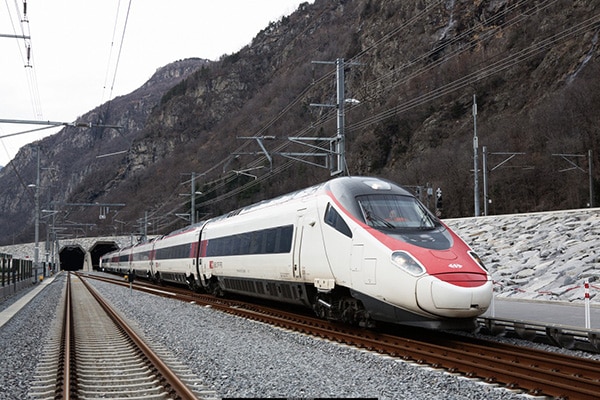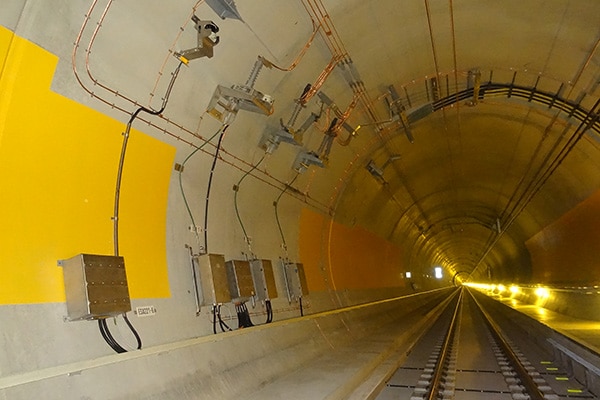After 17 years of construction, the Gotthard Base Tunnel finally opened to passenger and cargo traffic on 11 December 2016. Deployed as a sensor solution for protection of the overhead line, LMS511PRO laser scanners from SICK help ensure that the trains operate on schedule through the 57 km railway tunnel, the longest in the world.

They are incorporated into technical monitoring systems for protection of the electrical section breaks along the overhead line in the Gotthard Base Tunnel (GBT). Its necessary to separate the overhead line into sections due to operational and safety reasons. To ensure continuity of normal rail service, sections of the overhead line must be isolated from the grid for maintenance and in the evident of an incident, explains Patrick Hayoz, electrical engineer and Project Manager System Design Traction Current in the infrastructure department of SBB, the Swiss National Railway. Additional requirements apply in relation to tunnel capacity - up to 260 passenger and cargo trains on peak days - as well as the short train headways. To ensure high availability of the infrastructure, all fault risks should be eliminated, whenever possible, adds Patrick Hayoz.
Reliable detection of stationary pantographs
The GBT is constructed for speeds up to 250 km/h, which results in correspondingly high wind speeds and wind loads up to 10 kPa. Accordingly, the overhead line is constructed to sufficiently durable standards over its entire length: more than 100 km. Aside from the maximum train speeds, however, potential effects of an unscheduled stop in the tunnel also had to be considered. In electrical section breaks, two contact wires extend in parallel for almost twenty meters. If a pantograph remains stationary in such a position, the compensating current through the pantograph can cause the two contact wires to overheat at the contact point, says Patrick Hayoz, illustrating a familiar scenario. In turn, this can cause the contact wire to break, which usually means a track closure of several hours. Together with a committee of subject matter experts, he tested and validated a series of risk minimization solutions to prevent contact wire breakage. Of these, pantograph detection using LMS511PRO laser scanners from SICK proved to be the ideal solution - based on technical, cost-effectiveness and time considerations.
LMS511PRO: professional solution for precise detection tasks
Suitable for outdoor use, the LMS511PRO laser scanner from SICK is a 2D detecting and measuring sensor with a scanning angle of 190° and an operating range up to 80 meters; it offers adjustable angular resolutions between 0.167° and 1°. The system measures the pulse travel time of a diversified laser beam to an object - in this application, the pantograph - and the remission time from the object surface, explains Urs Baruffol, Industry Account Manager Logistic Automation at SICK AG in Stans. Along with adaptable software filter algorithms, the laser scanner's 5-echo evaluation technology ensures extremely dependable return pulse detection; it therefore produces highly reliable data regarding the presence, distance and position of the pantograph. In the case of a stationary pantograph in an electrical section break, this data is used to initiate a changeover of the overhead line supply. The changeover process should be completed in a maximum of twenty seconds to exclude the risk of spot overheating in the overhead line, says Patrick Hayoz.

Successfully validated at the SBB depot in Bern
The LMS511PRO is an industry-tested, rapidly deliverable standard system that has proven itself in a range of different applications. Its open interface concept offers maximum connectivity. Fresh from the factory, it therefore met significant SBB requirements determined by project progress at that time, tunnel use allocation for test drives as well as the approaching commissioning date. Next, the LMS511PRO underwent technical validation at the SBB depot in Bern - and passed with flying colors. The decisive features were its detection reliability, low installation outlay, connection to external systems as well as the remote control and configuration capabilities, summarizes Patrick Hayoz.
Tunnel view operating mode
All LMS511PRO units in the GBT are mounted on a specially developed support console adapted to the radii of the tunnel walls which protects the sensor, along with the electrical connectivity, from airborne small parts as well as misalignment due to high wind loads. The units are mounted overhead, which both simplifies cabling and enables the status indicator to be read from the ground. In operation the laser scanner works in tunnel view: it is oriented to view only the pantograph, preventing it from being distracted by another traveling train.
Remote access ensures availability
Durable housing technology, reliable detection and evaluation processes - the LMS511PRO is designed for maximum device availability. To ensure maximum availability even in the harsh everyday working environment, a remote access capability was set up to allow SBB access to the laser scanners via the GSM network, says Markus Schmid, Service Engineer at SICK AG in Stans. This makes it possible to monitor the systems for contamination or misalignment, analyze functions and measuring data during operation and even subsequently adjust individual parameters through software, despite the difficult access situation within the tunnel. The Gotthard Base Tunnel is sure to be one of the century's most prominent construction projects, setting the standard for an age, with its plethora of highly advanced safety devices. At SICK, were glad we could do our part to contribute a small yet sophisticated solution for protection of the overhead line and therefore help ensure the required availability of the new north-south rail axis through the Alps.
- Product information: 2D LiDAR sensor LMS5xx
- Product portfolio: 2D LiDAR sensors

